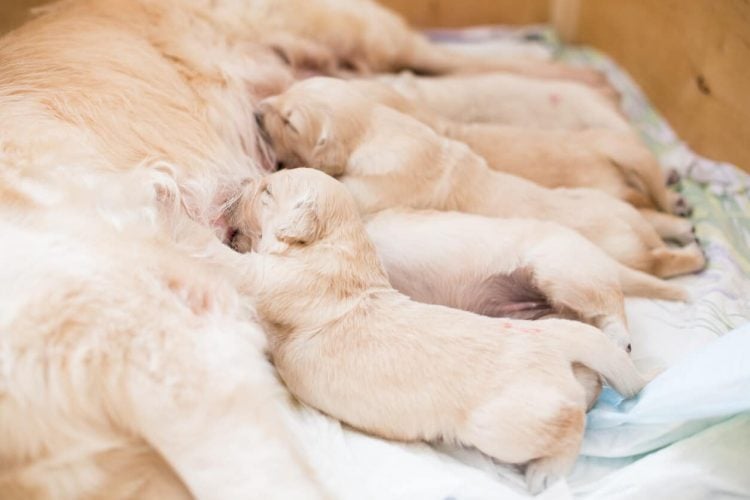- Not a substitute for professional veterinary help.
After all the research, planning, and puppy-proofing, you’re probably eager for the day you get to bring your new puppy home. The wait, however, can be tough, since puppies need to stay with their mothers for a minimum of 8 weeks—and experts increasingly agree that the best age to rehome puppies is closer to 10 or even 12 weeks.
To understand why a mother is critical to the first weeks of a puppy’s development, we spoke with Dr. Rhiannon Koehler, a licensed vet and consultant for TeachMeTo. We cover how breed and development guide adoption wait times—plus what to do if it turns out your puppy came home with you a little too early.
What Do Puppies Learn In the First 8 Weeks?
Puppies have a lot of important developing to do in the first 8 weeks of their life. They’re completely dependent on their mothers when they’re first born, and not just for food. They also receive important antibodies, warmth, socialization, and the confidence to navigate the world.
Safety
Newborn puppies can’t do much more than suckle and sleep. They’re unable to generate their own body heat. They can’t even see or hear until their eyes and ears begin to open around 2 to 3 weeks of age.
If a newborn puppy is separated too early, it takes a lot of work to keep them safe. They need close monitoring and an ambient heat source to keep them warm. Until at least 2 weeks of age, puppies also require stimulation to urinate or defecate. Their mother usually helps by licking them.
Nutrition
“If a puppy is separated from their mother at birth before nursing, they will not benefit from the nutrients and antibodies in their mother’s colostrum,” Dr. Koehler explains. That can lead to a weaker immune system.
After that first batch of mother’s milk, they need regular nursing, typically for 4 to 7 weeks until their teeth grow in. While puppies may show interest in soft puppy food as early as 3 weeks old, they’ll still need their mother’s milk until they’re able to eat enough solid food to sustain themselves.
Adopting an unweaned puppy means you’ll need to bottle-feed them commercial formula.
Socialization
Puppies learn to move through the world by observing their mother and interacting with their littermates.
Seeing their mother’s calm reaction to humans helps puppies learn to trust people. That’s especially important, since it isn’t until 6 to 8 weeks of age that puppies are capable of forming their own attachments to humans. Adopting a puppy too young could make the task of earning their trust a little more challenging.
Dr. Koehler points out that puppies separated from their littermates too early may also struggle to learn not to bite during play, since they won’t have been corrected by siblings and mother early on. Adopting a puppy who lacks this early socialization can add some extra work to your puppy training schedule.
Resilience
During the first few weeks before a puppy’s eyes and ears open, their mother is their primary source of comfort in a world where everything is new (and a little scary). Without that comfort, puppies may develop a nervous or fearful temperament.
Research shows the age puppies leave their mom impacts their response to unfamiliar environments in the future. According to some studies, puppies separated before 7 weeks of age tend to be more fearful.
-
Anastasiia Cherniavskaia via iStock
Signs a Puppy Is Ready to Leave Their Mom
To be ready to leave their mom, puppies don’t just have to reach certain milestones of physical development—they also have to have a degree of mental and emotional maturity.
Many breeders wait to separate puppies from their mothers until they’re 10 to 12 weeks old, Dr. Koehler explains, because those extra few weeks are crucial for gauging an individual puppy’s readiness.
Here are some signs a puppy may be ready to go to a new home:
- They’re fully weaned. The puppy should no longer be nursing or require supplemental formula. Their baby teeth should be in, and they should be eating well on commercial puppy food.
- They show interest in people. Once they become mobile, puppies start straying from mom to play with first their littermates, then friendly humans. A puppy who enthusiastically accepts human interaction may be ready to go home.
- They’re curious about new things. Well-socialized puppies have been exposed to different sights, sounds, and smells. It’s a sign of independence if they start to explore on their own without fear.
- They can self-soothe. Puppies should be able to calmly endure short periods of separation from their mother and littermates. It’s a sign of confidence if they just settle in for a nap or engage in solo play instead of whining or barking.
- They exhibit appropriate play behavior. A puppy who has learned basic social skills from their mother and littermates may be less likely to bite or scratch during play. This is important if you have young children at home.
- They’re healthy and hardy. A puppy should have a healthy body weight and condition for their age and breed before they leave their mom. They should have been seen by a vet at least once and, depending on their age, may have already had some vaccinations.
Risks of Earlier Separation
Early separation can impact everything from a puppy’s development and physical health to their emotional well-being and behavior. That doesn’t mean they’re bound to run into trouble—but raising them might come with additional challenges.
Puppies who leave their mothers before 8 weeks old run a higher risk of:
- Poor growth and development
- Nutritional deficiencies
- Increased susceptibility to illness
- Difficulty bonding with humans
- Fear of unfamiliar experiences
- Excessive barking or whining
- Biting during play
- Possessiveness over food or toys
- Difficulty potty training
- Destructive behavior
- Reactivity toward other dogs
- Sensitivity to loud noises
- Increased susceptibility to separation anxiety
-
Stanislav Hubkin via iStock
Breed Recommendation Timeline
“There isn’t an established breed-by-breed guideline for how long puppies need to stay with mom,” explains Dr. Koehler. But the general trend is to keep small breed puppies with their mothers for longer than large breeds.
The reason? Small breeds reach full size as early as 6 months, which makes early nutrition crucial. A few extra weeks of their mother’s milk can significantly impact their development.
Similarly, since some small breeds are prone to anxiety, they can benefit from additional time with their mother and littermates. The more socialization puppies get before they leave their mom, the better prepared they’ll be for life with their new family.
Here’s what experts say about when puppies can go to new homes based on breed factors.
| Breed Factor | Examples | Rehoming Age | Explanation |
| Toy breeds | Chihuahua, Havanese, Maltese, Pomeranian, Yorkshire Terrier, | 12 weeks | Toy-breed puppies are fragile. Early nutrition and extra time to develop help ensure they’re strong enough to continue development apart from their mother. |
| Small and medium breeds | English Bulldog, Bichon Frise, Cocker Spaniel, Corgi, Dachshund, Miniature Poodle, Shetland Sheepdog | 10-12 weeks | Early nutrition is key for healthy development, while extra socialization helps prepare small and medium breeds for life apart from their littermates. |
| Large and giant breeds | Akita, Bloodhound, Bullmastiff, Great Dane, Labrador Retriever, Rottweiler, Siberian Husky | 8-12 weeks | Puppies who don’t reach maturity until 12-24 months can still benefit from supplemental early socialization. |
| Anxious or fearful temperament | Australian Shepherd, Beagle, Chihuahua, Greyhound, Jack Russell Terrier, Shetland Sheepdog | 10-12 weeks | Breeds prone to anxiety or fearfulness may grow into more confident adults if they’re not separated from their mother or littermates too early. |
| Clingy personality | Australian Shepherd, Boxer, Cavalier King Charles Spaniel, French Bulldog, Golden Retriever, Labrador Retriever | 10-12 weeks | Breeds that tend to have highly affectionate or clingy personalities can benefit from extra early socialization to develop their confidence. |
| Working breeds | Australian Cattle Dog, Belgian Malinois, Border Collie, German Shepherd, Shetland Sheepdog, | 10-12 weeks | Delayed rehoming to allow more time for early training and socialization may benefit puppies bred for specific working scenarios. |
Bringing Home a Puppy During a Fear Period
Some pet parents worry that delaying bringing a puppy home past 8 weeks can make it more likely they’ll be rehomed during a fear period.
Fear periods are natural periods of increased sensitivity and anxiety that typically happen twice in a puppy’s life: first around 8 to 11 weeks of age, and then again when they’re between 6 and 14 months. During a fear period, your puppy might startle easily, hide more often, growl or bark at familiar people, and exhibit other signs of stress.
Bringing home a puppy during a fear period isn’t ideal, since it can make the adjustment a little harder on you and your new friend. The good news, however, is that fear periods usually only last 2 to 3 weeks.
If you bring home a puppy during a fear period, take things slowly. Focus on cultivating a sense of security for them in their new home. Be gentle and patient—don’t force them to interact, but use positive reinforcement to encourage them when they choose to.
Most importantly, don’t overcorrect for your puppy’s nervousness by coddling them. You could accidentally reinforce their fears when the goal is to boost their confidence and sense of independence.
What If I Got My Puppy Too Early?
Should you discover the puppy you’ve already adopted was separated from their mother too early, don’t panic. You can’t change the past, so focus on your puppy’s future instead. Besides, you’ve already cleared the toughest hurdle in increasing your awareness of the situation!
Here are some proactive steps you can take to help your puppy adjust to their new home and mitigate the potential side effects of early separation.
- Schedule your puppy’s first vet visit. Depending on how early your puppy was separated, their immune system might not be fully developed yet. A quick vet visit can help you assess your puppy’s current health status and make a plan for ongoing preventive care.
- Create a safe space for your puppy. It’s frightening to leave everything you know behind, so puppies can benefit from having a safe and cozy space of their own in their new home. A nice dog bed goes a long way, and some plush toys wouldn’t hurt!
- Focus on socialization. Exposing your puppy to new people, places, and experiences is key. Don’t overwhelm your puppy with too much at once, but be intentional about helping them form positive associations with new things.
- Use positive reinforcement training techniques. Start off simply by offering treats and praise each time your puppy interacts with you, responds to their name, or exhibits curiosity about their new home. When they’re old enough for more focused training, you’ll already have a foundation to work from.
- Get to know your puppy’s personality. The more time you spend with your puppy, the better you’ll get to know them and their individual personality. You’ll also develop an understanding of how they typically communicate and behave, so you’ll be more likely to spot a developing problem quickly in the future.
Above all else, be patient—with your puppy and with yourself. Raising a puppy is no easy task, and there’s no shame in asking for help. If you’re new to the game, consider enrolling your puppy in an obedience class or talk to a certified trainer to learn the basics. A good dog walker or sitter can help you beat the puppy blues and come back refreshed.






